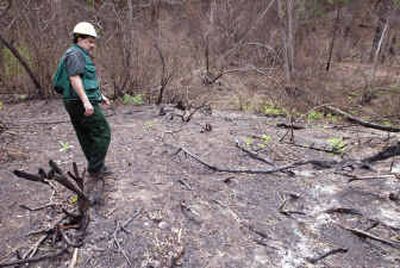Burn areas ignite mushroom industry

WENATCHEE – A tasty and lucrative industry is sprouting from the ashes of last summer’s wildfires.
Morel mushrooms – a bumper crop of them – are flourishing in blackened landscapes across the West, setting the scene for a gourmet treasure hunt from California to Alaska that is just now hitting its peak in parts of North Central Washington.
“In the West, fires mean morel mushrooms,” said Mick Mueller, a fire ecologist and mycologist for the Wenatchee River Ranger District.
The Okanogan and Wenatchee National Forests has issued more than 160 commercial permits so far this spring, mostly in the Chelan and Wenatchee River ranger districts, in areas burned by the Fischer, Pot Peak and Deep Harbor fires.
The heart of the multimillion-dollar cottage industry for wild morel mushrooms – prized worldwide for their earthy taste and texture – is eastern Oregon and Washington, where climate, forest conditions and the frequency of fires make perfect growing conditions.
After forest fires, the soil experiences a flush of nutrients from the burned vegetation the following spring that encourages morel growth, Mueller explained. Organic acids released into the soil act as a fertilizer for morel spores that can lie dormant for years.
While morels also sprout after other disturbances, such as logging or prescribed fire, mushroom pickers concentrate their efforts in wildfire areas because they cover a bigger expanse of landscape.
Wildfires burned nearly seven million acres across the West last year, mostly in Alaska. Washington and Oregon experienced higher-than- average fire seasons and, as a result, are producing a multitude of morels.
“We are buying 7,000 pounds a day from Washington and Oregon right now – much more than anywhere else,” said Matt Rensy, an international mushroom marketer for the New Jersey-based American Mushroom Hunter Corp.
Pickers are required to buy a $20 permit for every 100 pounds of morels they collect in the national forest. They turn around and sell them for $5 to $8 per pound fresh and up to $40 a pound dried, according to market data.
The mushrooms are sold to grocery stores, farmers markets, restaurants and international marketers who unload them overseas.
“Some of our customers in France and Germany are buying close to 40,000 pounds of morels a day,” Rensy said. “The U.S. market is very, very tiny compared to the European market.”
Mueller said Americans are “mycophobic” – fearing mushrooms – compared to Europeans and Asians. He said the morel is coveted over other mushrooms because it has a wilder, earthier taste.
“Morels are to other mushrooms what venison is to beef,” he said. “It’s more organic, free-range, darker and gamier than other mushrooms. And you hunt for it.”
Morels are the second-most lucrative mushroom found in north-central Washington forests, next to chanterelles, Mueller said, adding that a mushroom picker who works from California to Alaska can earn $10,000 in a season.
Pickers have been scouring the forests near Leavenworth and Chelan almost every day, especially on weekdays when fewer recreational hunters are out, according to loggers and U.S. Forest Service employees working in the burned areas.
Pickers keep to themselves, and are guarded about their picking areas.
“They are very secretive and scattered all over the place,” Mueller said. “There could be dozens of them out there, and you would never see them.”
For the past few summers, after big fires along Lake Chelan, mushroom hunters have taken boats uplake to search remote areas of the forest.
Mueller said some pack guns to protect themselves. But violence has not erupted in local forests like it has in Oregon, where collectors have gotten into gunfights over picking areas.
For the most part, the pickers are looking for areas where they can pick large quantities in a short time. Mueller recalled following a vanload of pickers a few years ago that stopped to search an area of local forest.
“The van stopped, and the pickers jumped out with five-gallon buckets and went on a march through the woods,” he said. “They went in a grid, and didn’t stop anywhere very long. They probably left 40 to 50 percent of the mushrooms behind.”
He said the commercial pickers don’t linger in areas like recreational ones do. “They are looking strictly for volume,” he said.
Rensy said morels are a difficult mushroom to work with, and the advent of overnight delivery has helped the market expand greatly in recent years.
“They can turn bad very fast,” he said. “They lose 15 percent of their weight within 24 hours of picking. They can be nice when you get them from the forest, but six to 10 hours later they can be completely wormy.”
The morel season is starting to slow down near Leavenworth, but it’s just getting started near Lake Chelan and in other higher-elevation areas, Mueller said.
The spring rains have helped prolong the season, and more rain could extend it even further.
“As with anything harvested from the wild, if Mother Nature is not good to you, you have nothing,” Rensy said. “But when she’s good to you, you can get so much.”